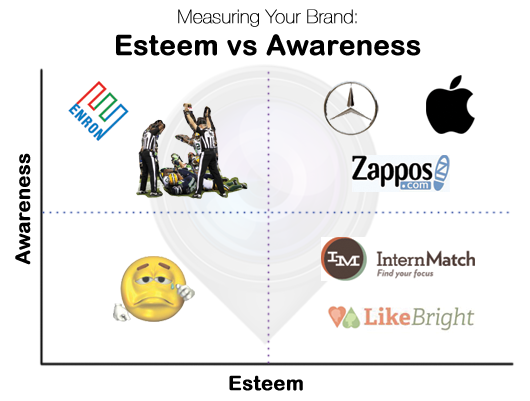There’s a simple exercise that is incredibly powerful when considering marketing, advertising, or branding a company. The practice can be applied to anything – a product, an event, even ourselves – by simply considering two variables: Esteem and Awareness.
Esteem
Esteem is what the brand is known for, or its image. This includes how much (or how little) the brand is respected, and what it’s respected (or disrespected) for. On one hand, there are brands associated with quality, great service, and other positive traits – like Apple, Zappos.com, and Mercedes-Benz. On the other, you’ve got those universally accepted as undesirable – companies like Enron, or the NFL Replacement Refs (had to…)
Awareness
Awareness is how well known a brand is. How big – or how small – its reach is. On one hand you’ve got Joe’s Pizza on the corner, serving the locals, and on the other you’ve got Pizza Hut, serving up slices from countless locations on every corner of the globe.
This is what branding is all about. Esteem and Awareness. As far as marketing, advertising, and branding are concerned, they’re the only things that matter. It all boils down to those two pillars. Everything else is secondary.
Practice
With all this in mind, here’s a fun trick: plot Awareness and Esteem against X and Y axis, and then split the graph into four quadrants.
In the top right, you’ll find the well known, and well respect brands. This is the sweet spot. Our examples from before – Apple, Mercedes-Benz, and Zappos – are all comfortably in this quadrant.
Below them in the bottom right quadrant, you’ve got well respected but lesser known brands. This is where you’d find high-end niche brands like Harmon Kardon (speakers), or newer startups earlier on their paths, like our friends at InternMatch (internship marketplace) and LikeBright (social dating) – both extremely valued and respected among the communities that know them (and growing every day).
On the left side, the Hemisphere of Sorrow. The top left: high awareness, low esteem. Our earlier examples of Enron and the NFL Replacement Refs fit nicely here.
On the bottom left: unknown, and unloved. The bottom of the barrel. No good examples are coming to mind, but the depths of Apple’s App Store or Amazon.com’s catalog are probably littered with examples of obscure, crappy products.
In Practice
There’s a couple takeaways from this exercise that we’re applying with SimpleCrew. The first is that esteem comes first. Whatever we do, it’s important that we maintain a great reputation, and that our app stays useful and valuable to our customers. The more the better. That is our top priority.
Awareness, while important, comes second. Our marketing and advertising efforts will grow as awareness grows in importance for us. But all the attention in the world is worthless without the esteem that comes from having a dialed-in product and customer support.
That’s the golden tip: Be good. Make it valuable, and make it work. Take care of the people who already know about you – they’re your foundation for esteem. Those early adopters can later become your biggest promoters. With that in place, then go to town on marketing and advertising.
Scale through the roof, but don’t forget your reputation along the way. Because awareness comes and goes, but esteem is your rep for life.
(Dig it? Sign up to get future posts by email.)



